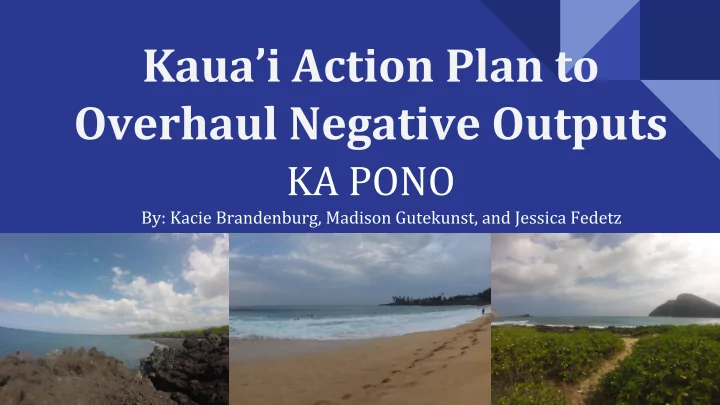

Background and History ● Monarchy until it became the 50th State in 1959. ● Under Queen Liliuokalani, political & economic systems based on watersheds, or ahupua’a, which functioned as an integrated land use and water system ○ Watersheds started at the peak of the mountain & extended to surrounding coral reefs ● The chiefs collectively “recognized that wise resource management and land use that avoided erosion and water pollution meant greater wealth for the political unit”
Background and History Continued ● Supreme Court deemed “ancient Hawaiian water and land customs” to be “ineffective,” choosing “more definite terms of ownership, land rights, and resource management” over traditional management (Macfarlane, 2014). ● Traditional ancient Hawaiian lands were determined to be ‘prescriptive,’ or “adverse possession,” which led to someone other than the original property owner gaining use rights to property. ○ This allowed native Hawaiian’s land ownership to be disregarded in legal contexts, especially in cases involving land use and sugarcane production (Levy, 1975).
Mission Statement KA PONO’s mission is to attain EPA fishable and swimmable status for all waters on the Island of Kauai by 2027 by reducing turbidity, total nitrogen and total phosphorus and maintaining a safe and clean environment for recreation.
Problem 1: Nitrogen and Phosphorus Issue: High levels of nutrients in the watershed due to high concentrations of agriculture on the island. Solution: Create buffer strips between agricultural land and water bodies ● Control invasive plants on 15,000 acres of land on Kaua’i ● ● Plant native species in areas that are vulnerable to erosion, totalling 15,000 acres
Problem 2: High Turbidity Issue: Steep elevation changes combined with erosion from agriculture contributes to fast moving waters and high turbidity. Solution: ● Create buffer strips between agricultural land and water bodies ● Control invasive plants on 15,000 acres of land on Kaua’i Plant native species in areas that are vulnerable to erosion, totalling 15,000 ● acres
Problem 3: Bacteria and Fecal Contamination Issue: High populations of feral ungulates near water bodies have contributed waste directly into the watershed. Solution: Maintain existing fencing and continue to control ● Feral Ungulate populations on 8,600 acres of protected land. Implement fencing and Feral Ungulate population ● control on 8,200 acres of land by FY 2022. ● Protect a total of 25,000 acres through fencing and Feral Ungulate population control by FY 2027.
KA PONO Goals ● Create buffer strips between agricultural land and water bodies ● Control invasive plants on 15,000 acres of land on Kaua’i Plant native species in areas that are vulnerable to erosion, totalling 15,000 ● acres ● Maintain existing fencing and continue to control Feral Ungulate populations on 8,600 acres of protected land. Implement fencing and Feral Ungulate population control on 8,200 acres of ● land by FY 2022. ● Protect a total of 25,000 acres through fencing and Feral Ungulate population control by FY 2027.
Recommend
More recommend